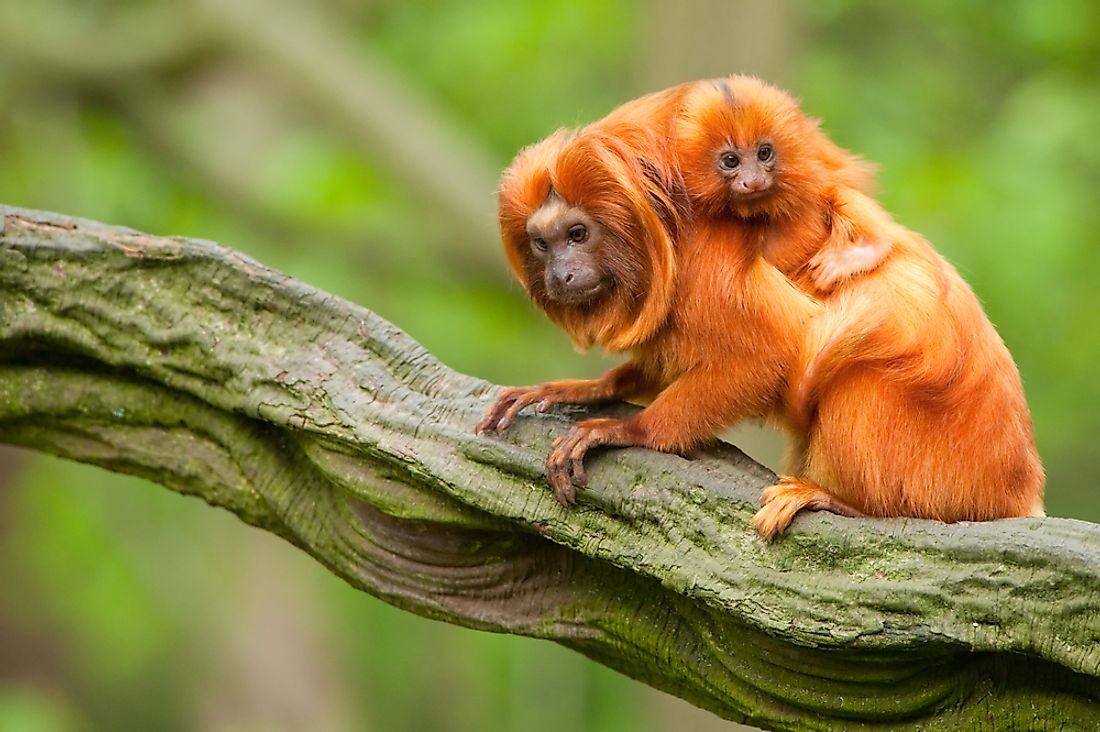The Four Species of Lion Tamarins

Lion tamarins are a group of four species of new world monkeys endemic to the Brazilian rainforests located on the eastern side of the country. The four species include the golden lion tamarin, golden-headed lion tamarin, black lion tamarin and the superagui lion tamarin. Lion tamarins are easily recognized from their fur, which resembles the mane of a lion hence their name. Their fur is golden, black, or a combination of both. Lion tamarins are arboreal and diurnal animals. The lion tamarins face constant threats in their habitat due to the shrinking size of the rainforests making most of these species endangered or critically endangered. Lion tamarins are social animals living in family groups of either a dominant male or female and juveniles. These groups mainly consist of a breeding pairs (existing in a polyandrous, monogamous, and sometimes polygamous relationship), and their offsprings. Both males and females within the group take part in raising their young. Due to their extensive foraging habits, lion tamarins play a crucial role in the dispersal of the seeds of plants that they feed on. Lion tamarins are omnivorous feeding on plants as well as animals such as insects, snakes, snails, lizards, and frogs. Their dietary habits may differ slightly from one species to another. During the night, lion tamarins sleep mainly in tree holes. They may mark their tree holes with scent, making it easier to locate them when threatened. However, this scent also exposes them to predators.
Some of the threats facing the lion tamarins include habitat loss through deforestation, agricultural activities, urbanization, predation, and illegal hunting. In an attempt to increase their populations and protect the existing ones, the Brazilian government has initiated conservation measures such as introducing protection areas such as reserves, the reintroduction of species into their original habitats, creating public awareness, introducing education programs, and translocation. Translocation involves removing tamarins from small unsafe habitats to larger and protected areas. Lion tamarins that live in small isolated areas face an increased risk of population decline due to inbreeding which reduces genetic diversity and ultimately the likelihood of survival of the offspring.
4. Golden Lion Tamarin
The golden lion tamarin is so named from the golden color of its body fur. The golden lion tamarin is an endangered species with a small population of 490 individuals in the protected area and about 3000 in the wild. The average golden lion tamarin male or female has a length of 10.3 inches and weighs about 1.37lb. The species is distributed in the tropical rainforests mainly towards the south-east in biological reserves and on private land. The golden lion tamarin spends most of its day foraging for about 12 hours sometimes foraging for shorter periods depending on the prevailing weather. During the warmer days, the golden tamarin forages for shorter times and for longer times during the drier days. The golden tamarin is omnivorous feeding on fruits, insects, flowers, rotten logs, leaf litter, palm crowns, bird eggs, and small vertebrates. The golden tamarins live in family groups of two to three adults and juveniles. Reproduction among this species depends on rainfall availability with mating at its peak towards the end of the rainy season.
3. Golden-Headed Lion Tamarin
The golden-headed lion tamarin is an endangered species of the lion tamarin that dwells in mature forests of the lowland and premontane tropical rainforests of Bahia. The golden-headed lion tamarin has golden colored fur on its face arms, tail and legs while the rest of the body is covered in black fur. This species is omnivorous feeding on flowers, fruits, nectar, plants, frogs, snails, lizards, spiders, and other small invertebrates. Due to its wide variety of diet, the golden-headed lion tamarin does not venture much outside its home range. However, when one group meets with another, aggression is common.Habitat reduction has contributed majorly to the decline of the golden-headed lion tamarin posing a huge threat of extinction to the species.
2. Black Lion Tamarin
The black lion tamarin or the golden-rumped tamarin is an endangered species endemic to the state of Sao Paulo, Brazil. The species, previously thought to be extinct was rediscovered in 1970 and is one of the rarest new world monkey species. The species has a limited geographical range as it is found almost exclusively in the Morro do Diabo State Park. This lion tamarin shows seasonal variation in dietary preferences depending on the present habitat. Feeding preferences also change from day to day or even month. On average, the black tamarin spends most of its time foraging within its habitat for insects, gum of trees and fruits. Like the other lion tamarin species, the black tamarin lives in social groups of adults and juveniles. In these groups, all members participate in the rearing of the infant through sharing of food. The black lion tamarin faces the highest risk among all species of lion tamarins due to its limited distributed habitat loss and deterioration as well as hunting and unprotected areas.
1. Superagui Lion Tamarin
The Superagui lion tamarin is also known as the black-faced lion tamarin. The species is a critically endangered one found in the Brazilian coastal forests on the southeastern region of the country. The black-faced lion tamarin has a black fur coat on the head, tail, and legs while the rest of the body is covered in golden-orange fur. The diet of the black-faced tamarin consists of insects, fruits, nectar, spiders, snail, and mushrooms (especially during the dry season). Like all the other lion tamarins, the superagui lion tamarin lives in family groups with a breeding female per season. The reproduction season is mainly between September and March mostly with twin births per female. Illegal pet trade, hunting, habitat loss and fragmentation are the leading causes of the decline in the number of the species.











